American Water
At American Water, Susan Hardwick is CEO and John Griffith is President.
No one can survive without potable water, but we also want it to be safe, clean, reliable, and affordable. That is a tall order for the complex systems that deliver our water, with many that are aging or too small to bear the investments needed for infrastructure improvements.
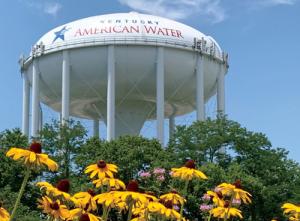
That is why a leading company, American Water, is so important. It aims to provide a superior customer experience across a diverse customer base and be the trusted leader in water quality, water management, system resiliency, and environmental stewardship. It's a lot to accomplish.
Water and wastewater services are needed in every community in order to thrive. American Water CEO Susan Hardwick and President John Griffith discuss here the challenges they are overcoming as they grow to provide more and better water and wastewater services.
PUF's Steve Mitnick: Talk about your roles in the company and what a typical day is like.
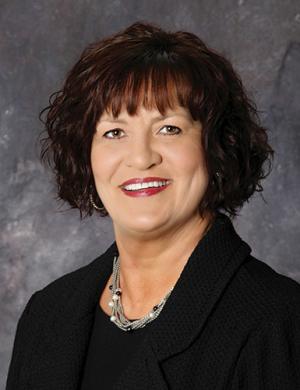 Susan Hardwick: It’s difficult to think of an industry-wide catalyst that would bring the change to address the country’s infrastructure needs. We’re trying to create the catalyst. We’re reaching out to regulators, policymakers and the like, emphasizing the work needed to provide safe, clean, reliable, and affordable water and wastewater services.
Susan Hardwick: It’s difficult to think of an industry-wide catalyst that would bring the change to address the country’s infrastructure needs. We’re trying to create the catalyst. We’re reaching out to regulators, policymakers and the like, emphasizing the work needed to provide safe, clean, reliable, and affordable water and wastewater services.
Susan Hardwick: I'm the Chief Executive Officer of American Water. That's a relatively recent change. On August 1st of this year, as part of our ongoing succession planning, we made the change to name John as our President of American Water. I was the Chief Executive Officer and President prior to that change.
Considering both of those roles combined, we're responsible for the execution of our current strategy, delivery of service, and the development of our longer-term strategy. While the two roles are separate now, we both work closely with the rest of the management team.
The President's role is about execution. It is focused on how we are delivering value, both from an operating standpoint and from a key stakeholder perspective.
My job is to think longer term, about the future, where the industry is headed, what are potential challenges to our strategy, what is our role in this industry, and how do we deliver value to all our stakeholders. It's helpful to separate those responsibilities to unlock the ability to strategize even more.
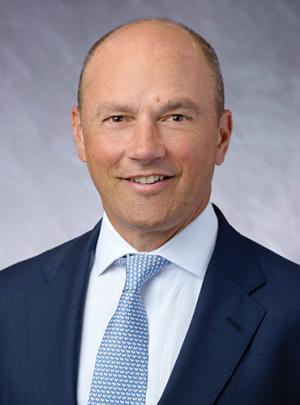 John Griffith: It’s getting more complex for small operators to manage. EPA’s new PFAS rule was implemented this year. PFAS are commonly known as forever chemicals. It takes planning, capital, and operating capability to remediate for PFAS and to do it cost effectively. It’s much easier done with scale.
John Griffith: It’s getting more complex for small operators to manage. EPA’s new PFAS rule was implemented this year. PFAS are commonly known as forever chemicals. It takes planning, capital, and operating capability to remediate for PFAS and to do it cost effectively. It’s much easier done with scale.
John Griffith: What makes American Water unique is the number of states in which we operate. We're in fourteen states across the country.
In addition, we serve eighteen military bases working closely with the Department of Defense to provide water and wastewater services to those serving our country.
Like any utility, our cycle of serving customers, investing in our systems, and raising capital starts with regulatory execution. Given the number of states where we have operations, we're in the regulatory arena on a regular basis.
Also, with our scope, scale, and operating capabilities, we've been purposeful with our business development program by acquiring medium- and small-size municipal systems, and in the process helping communities solve water and wastewater challenges, such as PFAS, lead and copper, and other critical issues arising from under-investment of capital and deferred maintenance.
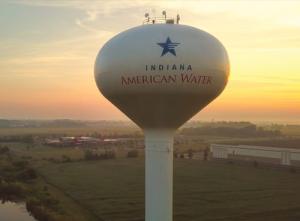 I-65 Water Tank.
I-65 Water Tank.
PUF: Susan, talk about the need for more investment in the nation's water infrastructure, which has been neglected.
Susan Hardwick: It's so neglected, in part, because of the fragmentation of the industry. Our water systems are set up on a local basis in this country, unlike the electric industry, and the gas industry to a large degree.
There are fifty-two thousand community water systems, and another sixteen thousand wastewater systems, as compared to just a few thousand systems for electric and gas.
With so many operators, having consistent investment philosophies is almost impossible. Small communities have many funding priorities and the primary source of revenue, or cash flow, is from property taxes and utility revenues. When deciding where to spend money, sometimes putting pipes underground falls lower on the list of priorities.
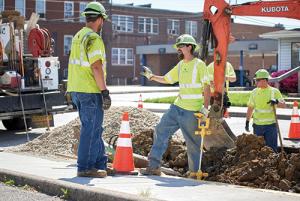 West Virginia American Water employees on the job improving water infrastructure by installing new water main. These infrastructure upgrade projects are part of West Virginia American Water’s investment of more than $97 million in upgrades across the state in 2024.
West Virginia American Water employees on the job improving water infrastructure by installing new water main. These infrastructure upgrade projects are part of West Virginia American Water’s investment of more than $97 million in upgrades across the state in 2024.
Many of these fifty-two thousand water providers do a fine job, but the ability to integrate systems, and achieve efficiencies from running a larger system, as it's done on the electric side, doesn't exist. This fragmented network results in lagged investment in water and wastewater infrastructure.
For example, as a country, we're on a two-hundred-year replacement cycle. American Water leads the industry, reducing that timeline to roughly one hundred twenty-five years. That means it takes that long to go through our system and make the needed replacements.
PUF: The gas distribution industry, to get the safer pipes, with regulator help accelerated that replacement time from thirty or forty years, down to fifteen or twenty for safety.
Susan Hardwick: I've been in the gas, electric, and water industries. For the gas industry, the real catalyst was a catastrophic incident like the San Bruno explosion in California, and Columbia's explosion in Pennsylvania. Regulators said, "We need to solve the safety issues in the gas distribution industry."
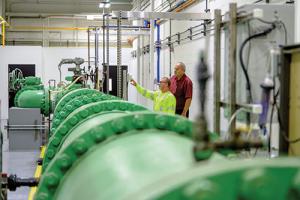 New Jersey American Water employees monitoring the water system at the Oak Glen, N.J. water treatment facility. The company provides water and wastewater services for approximately 2.9 million people in the Garden State.
New Jersey American Water employees monitoring the water system at the Oak Glen, N.J. water treatment facility. The company provides water and wastewater services for approximately 2.9 million people in the Garden State.
The industry developed pipeline safety regulations that went into effect and established clear compliance standards. Utilities had to replace their bare steel, cast iron pipe in the short term, period.
With the electric industry, there were a couple of catalysts. There has been and continues to be a change-over of generation capacity and grid investment driven by renewable portfolio standards and grid hardening to combat wildfires in the west and big outages in the eastern United States from catastrophic storms.
The electric companies said, "It's going to take all of us to solve these problems." Bringing that philosophy together forced that industry to think about who they are, and the role they play in providing safe and reliable electricity.
Contrast that to water, with fifty-two thousand system operators. It's difficult to think of an industry-wide catalyst that would bring about the kind of change needed to ultimately drive a faster or more consistent approach to addressing the country's infrastructure needs.
 New Jersey American Water’s treatment plant in Oak Glenn, N.J. The company is the largest regulated water utility in the state.
New Jersey American Water’s treatment plant in Oak Glenn, N.J. The company is the largest regulated water utility in the state.
We're trying to create the catalyst. We're reaching out to regulators, policymakers and the like, emphasizing the level of work needed to be done to provide safe, clean, reliable, and affordable water and wastewater services.
As we create that catalyst and drive the urgent response to this investment need, there are going to be customers challenged with their ability to pay. We must be more creative in the regulatory arena, ensuring low-income tariffs and a menu of assistance programs are in place in our service areas.
We are very active in Washington D.C., trying to facilitate a federally-funded customer-assistance program for water, like is currently in place for gas and electric customers. There was a temporary water-assistance program in place during COVID.
Those funds have run out and we must have permanently funded programs in place. This is where the federal government can immediately help in supporting the accelerated infrastructure investment programs companies like American Water have embarked upon.
PUF: John, when you deal with the regulatory community, how do you bring across the need for infrastructure investment?
John Griffith: PUCs are generally responsive to all the investments we make. To their credit, they do their homework and understand the need, and they support full recovery of those investments.
Whether PUC, DEP or other stakeholders, when they see a before-and-after of systems we own or acquire, the need is easy to see. In their most recent study, the American Society of Civil Engineers gave a C- grade to U.S. drinking water systems, and a D+ grade to U.S. wastewater systems. It's not where we want to be as a country.
It's important for us to continue to educate all stakeholders. As we make needed investment, customer bills are impacted, and we work hard to mitigate bill increases through efficient operations and other measures.
PUF: Susan, what are the consequences of underinvestment in water in comparison with electricity?
Susan Hardwick: Let's talk about the consequences of underinvestment. In the U.S., drinking water systems currently lose at least six billion gallons of treated water, or about nine thousand Olympic-size swimming pools, every day. That is treated water, meaning it went through the whole treatment process, and it is lost before it gets to the customer.
There're a variety of reasons. It's leaky pipes, non-existent pipes, bad valves, bad meters, and bad metering and billing practices. All of it ends up as unaccounted-for water. That is just one example.
PUF: If you could capture that lost water, there would be cost efficiencies and environmental benefits.
Susan Hardwick: Yes. It is estimated that lost water costs the nation almost eight billion dollars a year. It's a huge number. It's a slice of the data on the water infrastructure issue that has to be put in context to understand.
I've been thinking of ways to better communicate the issue of underinvestment in water systems. It's rare that you turn on the faucet and water doesn't come out. But you have no idea whether that water meets all quality standards and is consistently safe to drink.
When people think about it in that context, it helps them understand the need for continuing to evaluate our systems, looking at the safety and reliability of the infrastructure that delivers water.
We're trying to make sure there is a higher awareness so there is the proper focus on regulation. For example, in several of the states we operate in, we have advocated for water quality standards that apply to all suppliers.
Federal regulations, now on PFAS and lead and copper, help drive further compliance. For a company like us, because we are focused on compliance, we are ahead of many of those issues.
PUF: John, in the regulatory world when you're trying to make these cases, what's the pushback?
John Griffith: There's broad acknowledgement that the investment is needed. We get little pushback on the idea of continuous investment and there's abundant evidence to support the need.
In several of our states, it's not uncommon for the commission to come to American Water and ask us to take over systems that have been chronically under-invested and need better service, whether it's safe drinking water or clean wastewater. But again, it's important to make the timely investments and focus on affordability at the same time.
PUF: Susan, why is it so difficult to consolidate this industry?
Susan Hardwick: It starts first with the concept I mentioned earlier; water comes out of the faucet, so everything's fine. Then it goes back to the fact that water is so local and often, a primary source of revenue for many of these communities.
Cashflow to be able to do X, Y, or Z community project is vital. Although, when systems are sold, communities invest that money for longer-term needs. Helping community leaders understand that is a key element of our acquisition model.
Water is personal to people. It's the only ingestible utility. People want to know and trust their water provider, so there is a lot of education and on-the-ground engagement that is needed.
To get any sort of scale at fifty-two thousand systems, with the majority serving ten thousand or less customers, you've got to do many transactions to make a dent.
It's tough to do.
PUF: John, how do you do that with medium-size and small systems?
John Griffith: It happens at a local level. It's common for us to acquire a system, make investments and provide solutions, and then mayors or town council people from surrounding towns call us up and say, "Hey, can you help us too?"
It's getting more complex for small operators to manage. EPA's new PFAS rule was implemented this year. PFAS are commonly known as forever chemicals; they don't degrade. It takes planning, capital, and operating capability to remediate for PFAS and to do it cost effectively. It's much easier done with scale.
So, the need is there, and American Water has the tools to acquire and upgrade systems, but each one takes time and effort. We are organized to do that.
PUF: Susan, what can commissioners, staff, governor's offices, state legislators do to help you consolidate more, invest more, get service levels up across the industry?
Susan Hardwick: We find the greatest support from the regulatory environment. They understand the need for infrastructure investment. But there continues to be a challenge in under-regulated systems.
What legislators can do, and how regulators can be helpful, is support legislative solutions for systems to consider selling their system at a fair value, and to consider water quality accountability legislation that defines the standards and holds all water providers accountable. They can also help raise awareness of the challenges.
PUF: John, talk about fair market value.
John Griffith: Fair market value is when a purchase price is agreed upon by the buyer and the seller, appraisals are done to ensure the purchase price is appropriate, and then the purchase price is included in the rate base. Fair market value supports regionalization to improve service and drive efficiencies, which we think is good public policy.
PUF: Why would a state not want to do this?
John Griffith: Almost all our states do want to do this, because they see that the value of regionalization outweighs the cost of paying a premium over book value to incentivize the municipality to want to sell.
PUF: What are some of the important things everyone should know about American Water over the next two, three, four years?
Susan Hardwick: American Water is the leader in the water and wastewater utility industry in terms of our size, technological ability, and delivery of service.
We have operating and technical expertise. We are at the forefront of issues as they relate to our industry, such as treating contaminants.
We're fully capable with a breadth of expertise in advancing this infrastructure investment imperative. We have the capital, the crews, and engineering expertise. And, we have the expertise in the regulatory arena to manage investment and affordability on behalf of customers.
We believe this is a mission-driven business. What's important is to deliver safe, clean, reliable, and affordable water and wastewater services to more people in this country.
John Griffith: The future is bright. Right now, we are investing to solve critical issues such as the PFAS, lead and copper line replacement, and water scarcity through desalination and recycling.
But there will be other challenges in the future and we're ready to tackle those. We'll be doing what we're doing now for another hundred years. The work we do is critical, and we're going to keep growing.



